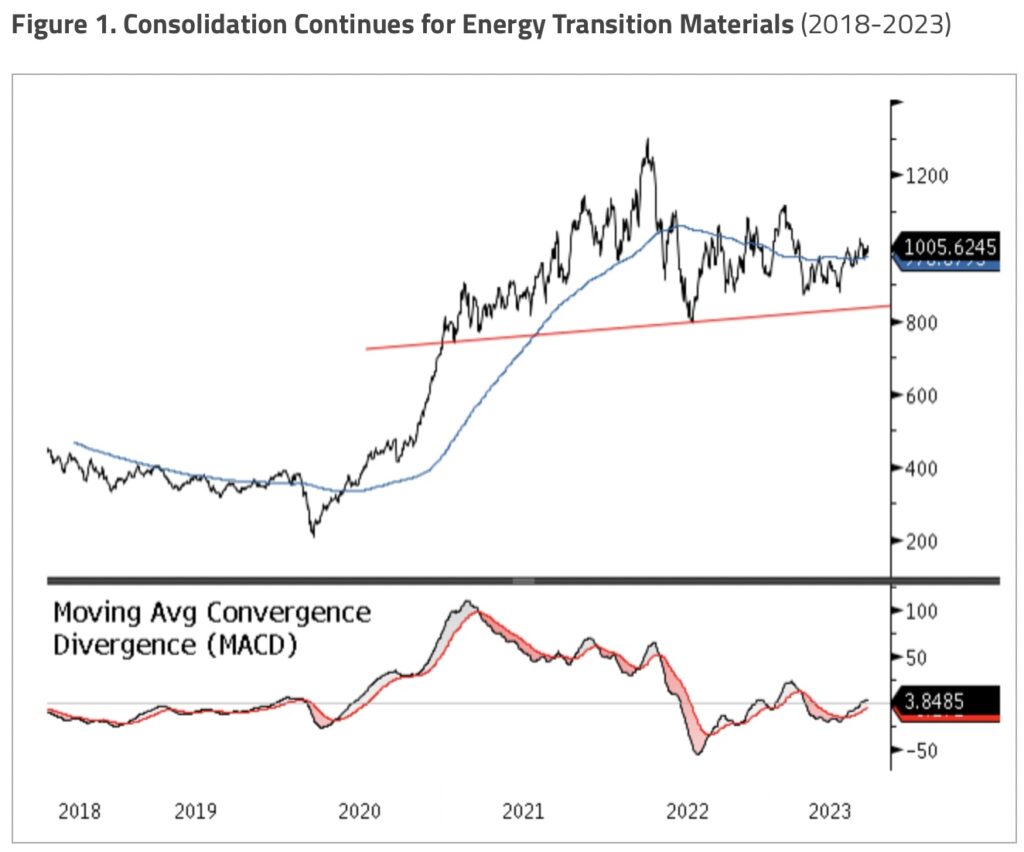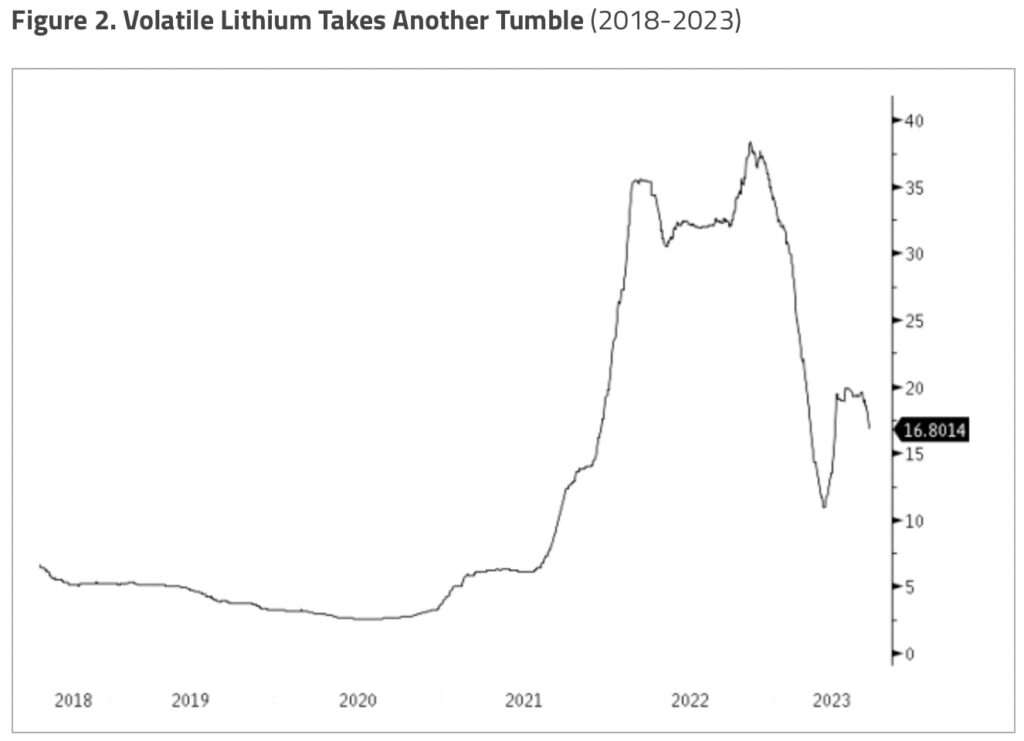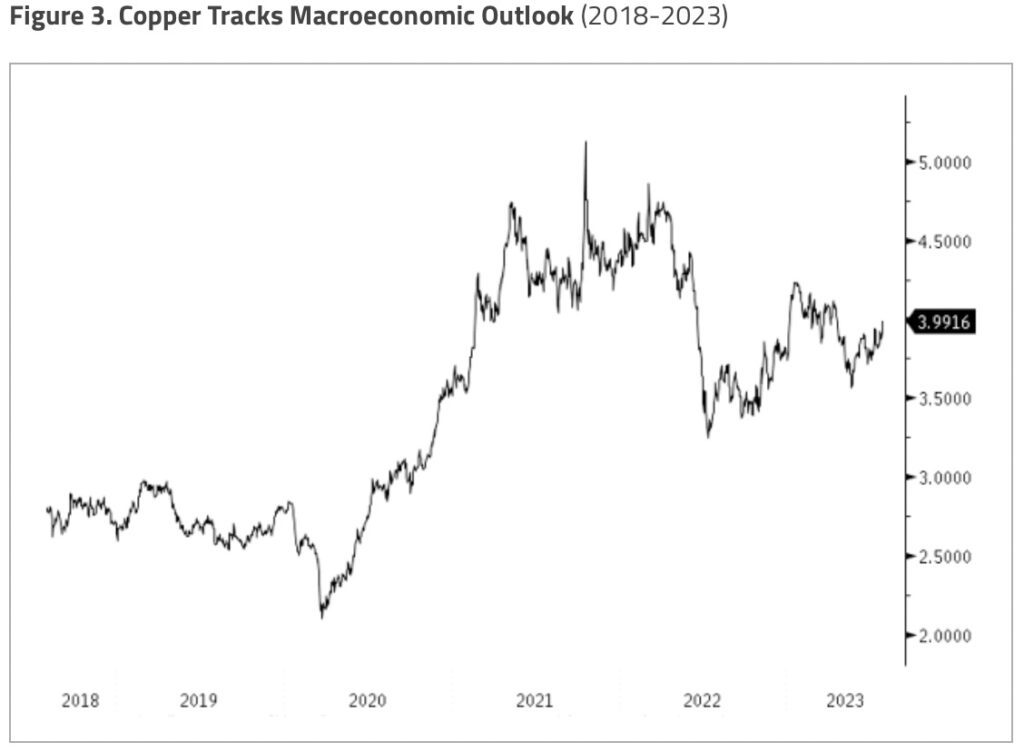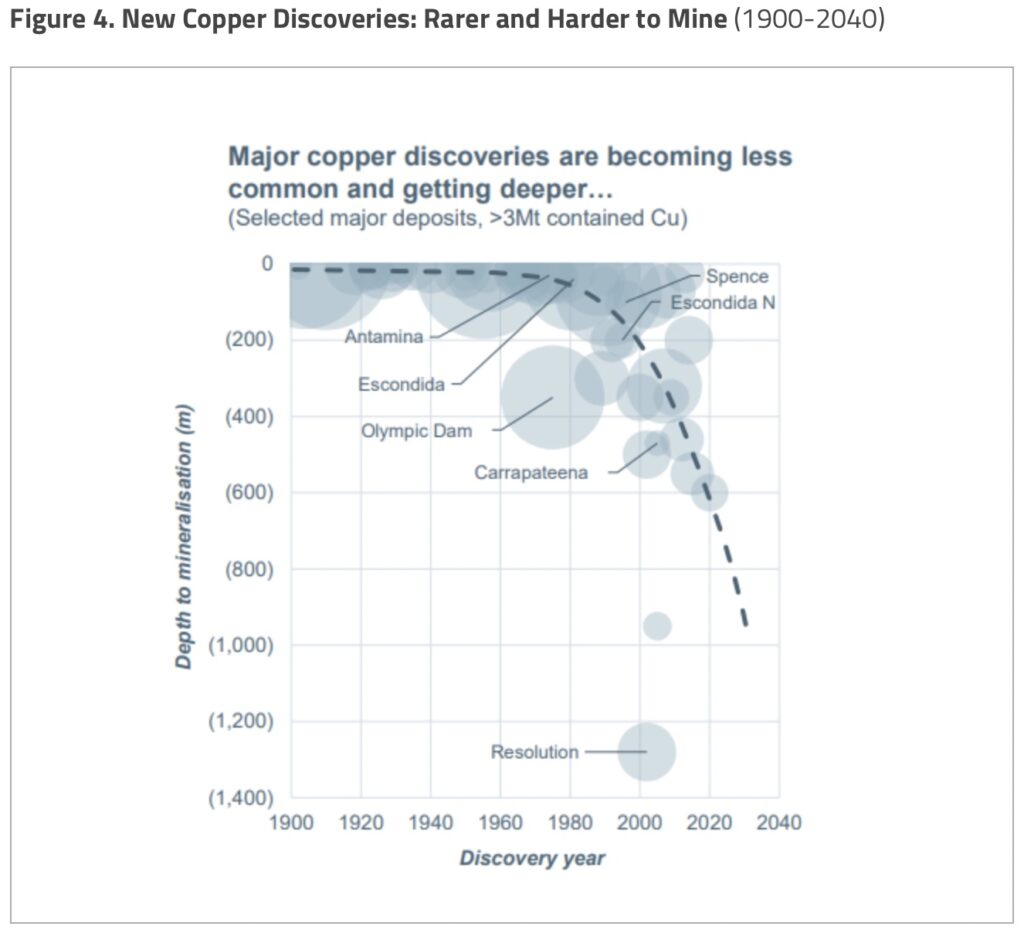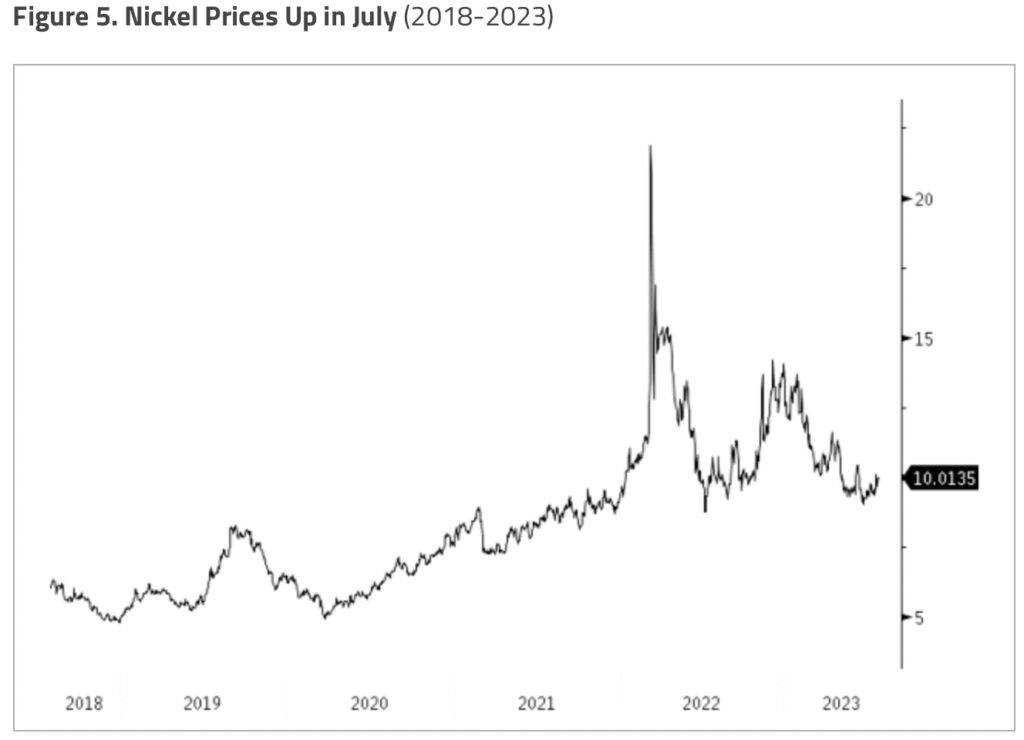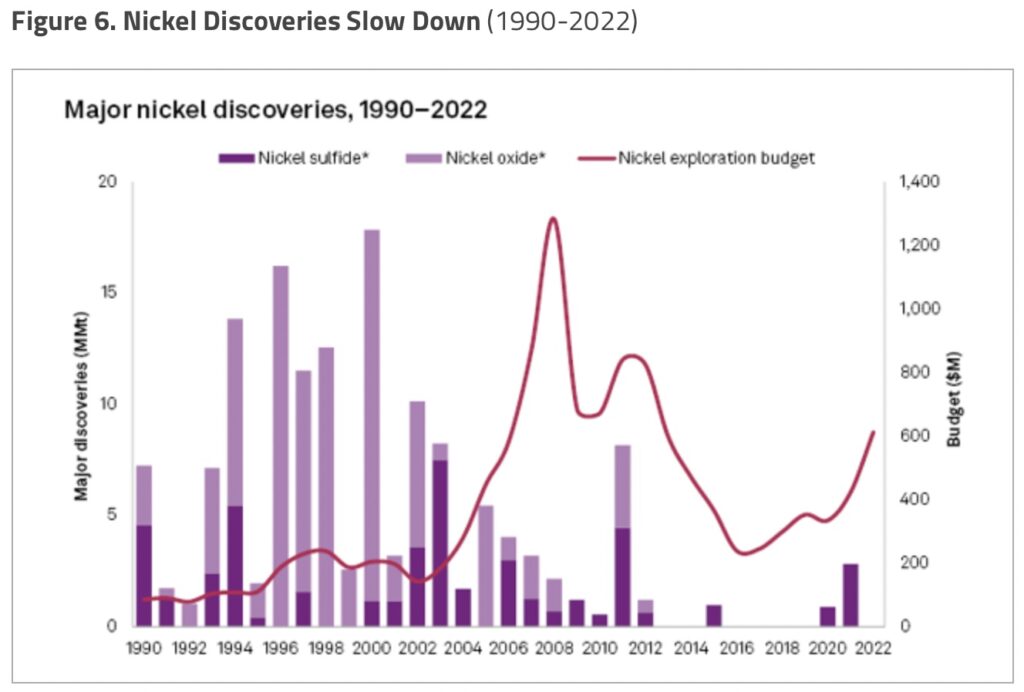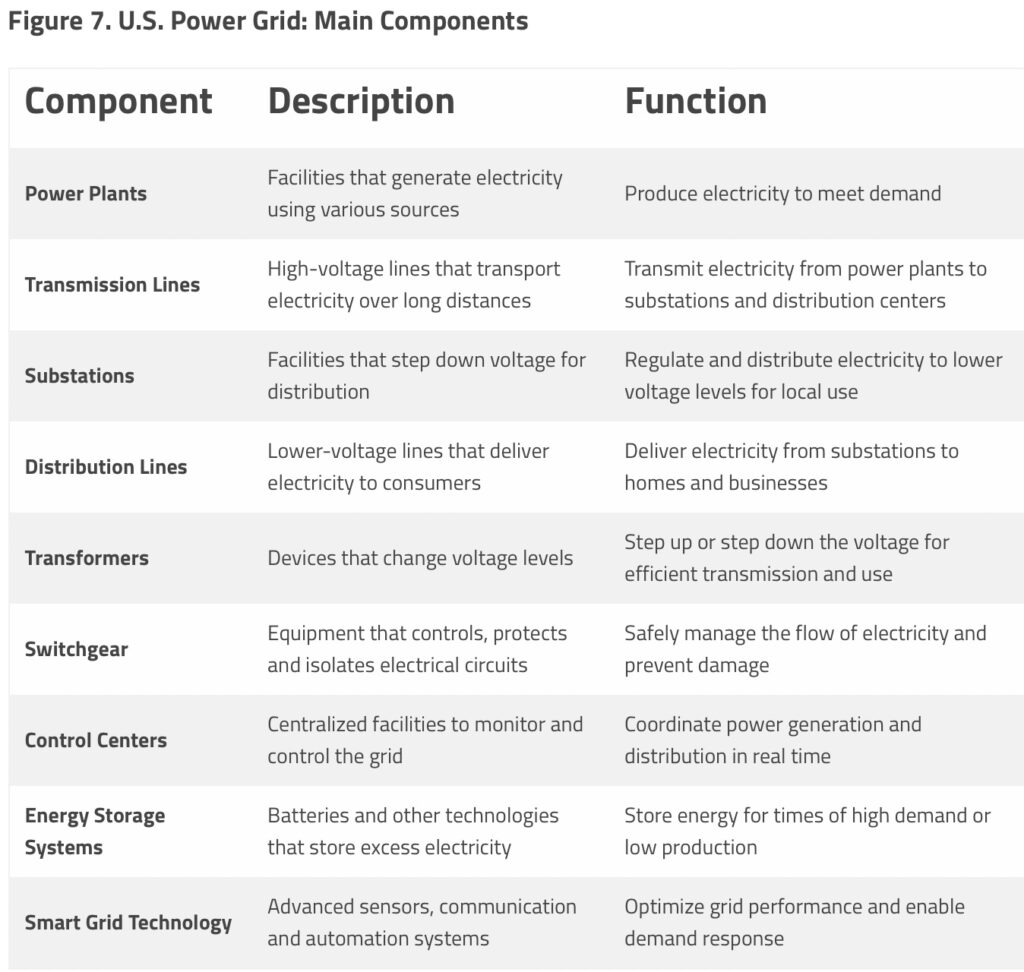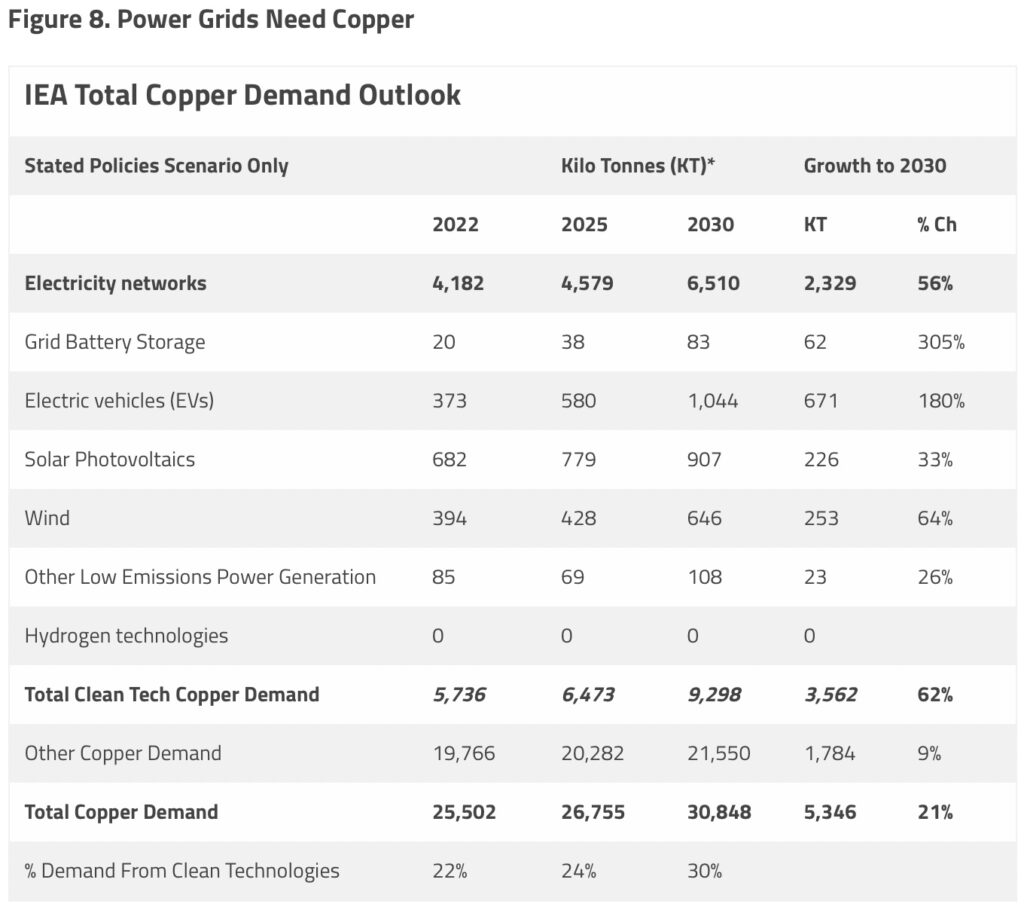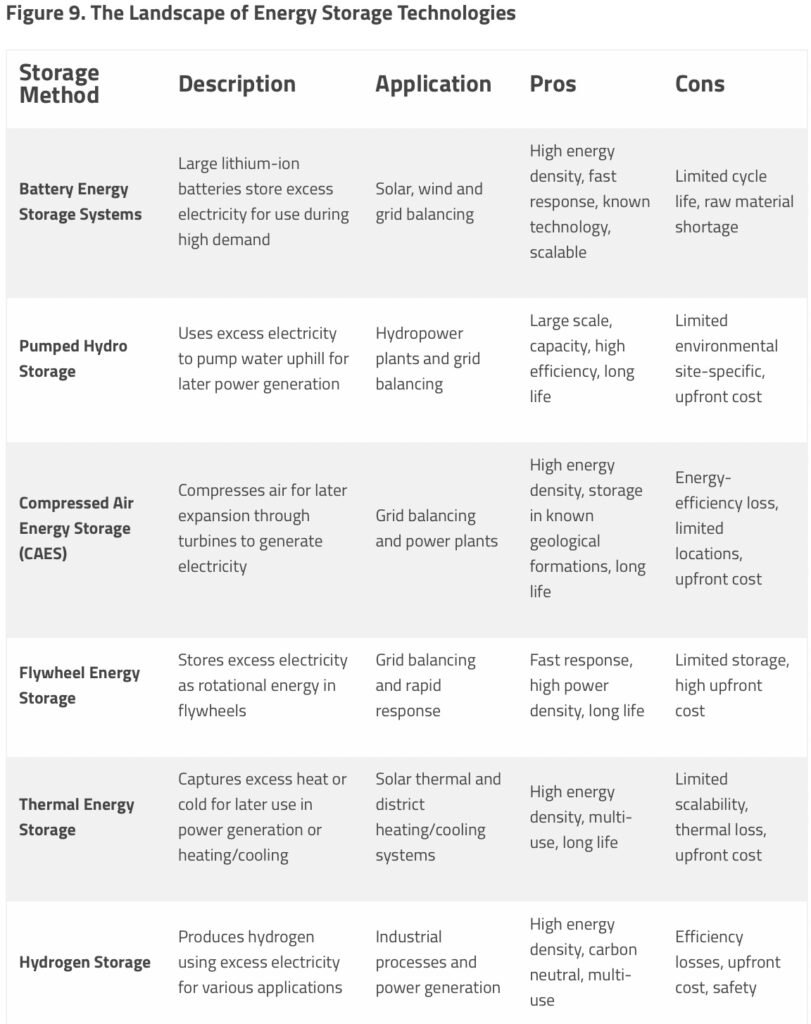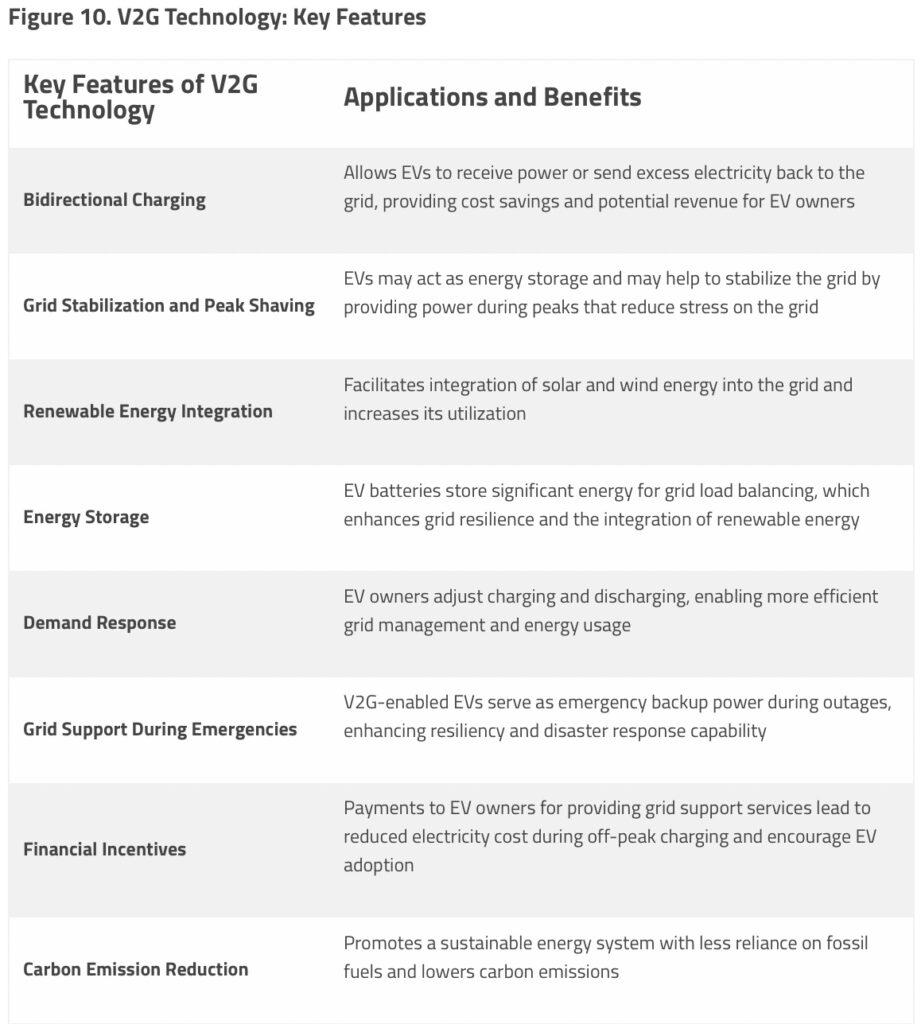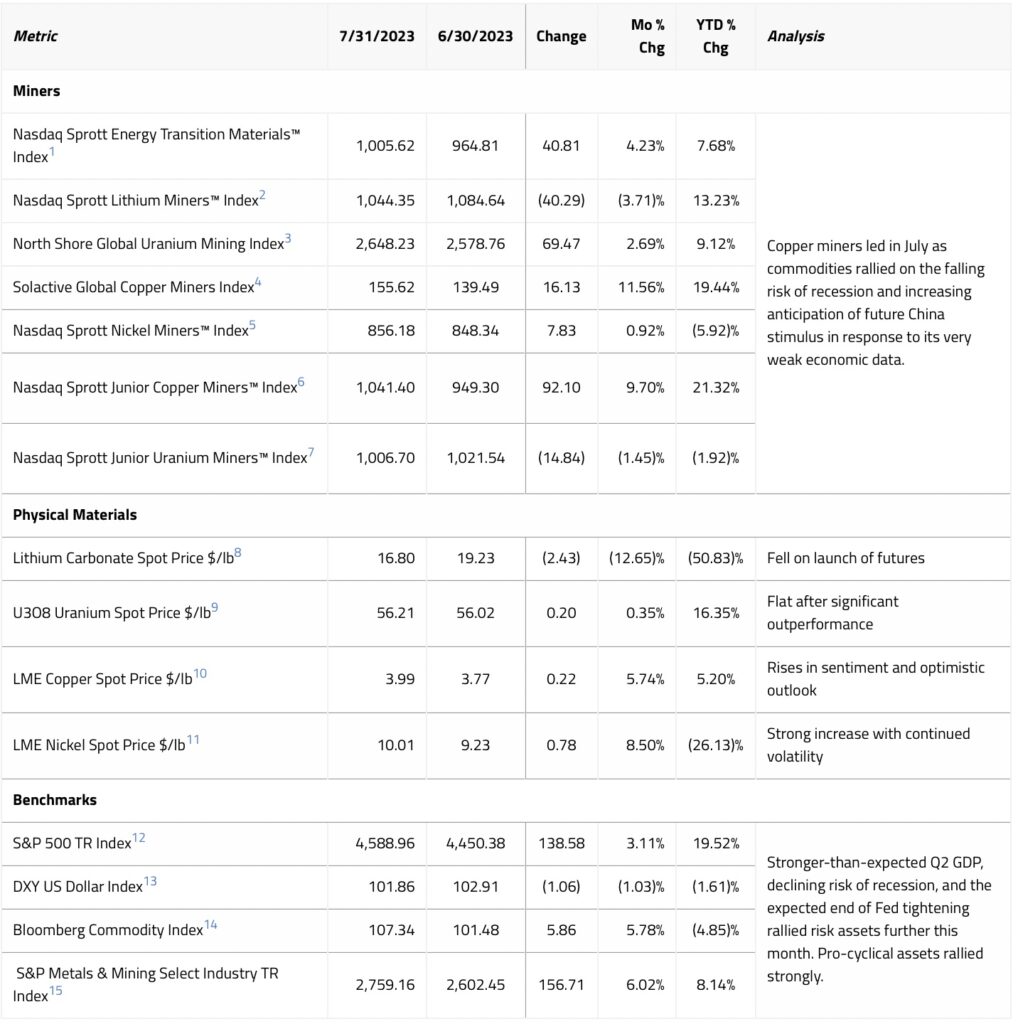Here is a look at copper, the metal everyone needs to own.
Growing Urgency to Modernize U.S. Power Grid
August 14 (King World News) – Paul Wong, Market Strategist at Sprott Asset Management: The Nasdaq Sprott Energy Transition Materials™ Index (NTSEM) rose 4.23% in July to close the month at 1,005.62. It was a strong recovery month for conventional metals miners, as witnessed by robust returns for copper miner stocks and rising base metal prices. Commodities staged a strong recovery as the risk of recession in the U.S. was pushed out further and the potential for a soft landing picked up momentum. The anticipation of further financial stimulus from China also contributed to a positive outlook. China continues to post economic numbers weak enough to hint at deflation risk — a considerable risk for an over-leveraged country.
Lithium carbonate prices and lithium miner stocks pulled back on a tumble in China’s lithium futures market. But after the recent recovery, a minor pullback was not unexpected. Uranium and uranium miners were flat in July after a significant June rally. Copper, particularly copper mining stocks, had a solid recovery in July, breaking through several notable technical resistance levels on large trading volumes. Overall, the NSETM Index continues to consolidate (Figure 1).
Updates on Critical Minerals
Lithium: China Futures Trigger Price Declines
In July, the lithium carbonate spot price fell 12.65% to $16.80 per pound, and lithium mining stocks dropped 3.71%. Lithium’s performance in July marked a continuation of its volatility (Figure 2). The lithium carbonate spot price is now approximately 55% above the recent low of April 25, 2023, but 56% below its recent high on November 14, 2022. Over a longer horizon, however, the lithium price is still above its historical levels.
Lithium was stable for most of July until the first lithium carbonate futures contract was launched on the Guangzhou Futures Exchange on July 21. On its first day of trading, contracts for January 2024 delivery fell below their daily limit, triggering a price decline and putting the lithium market into backwardation. As of this writing, the lithium carbonate price for January 2024 delivery is $14.42 per pound in U.S. dollar terms and reflects market expectations of a further decrease in the spot price.
We note that the establishment of a lithium futures market provides market participants with a mechanism to hedge risk and delivers greater pricing transparency. Both have the potential to help mitigate the extreme volatility in the current lithium spot market…
ALERT:
Billionaire mining legend Pierre Lassonde has been buying large blocks of shares in this gold exploration company and believes the stock is set to soar more than 150% in the next 6 months. To find out which company CLICK HERE OR ON THE IMAGE BELOW.
 Sponsored
Sponsored
Lithium miner stocks fell less than the lithium spot price in July. Generally speaking, the valuations of lithium miners already reflected the expectation of even lower lithium spot prices, which are still above producers’ costs. Lithium miners are also being buoyed by the increasing recognition that the long-term outlook for lithium demand is very positive.
In July, several noteworthy organizations released reports on critical minerals. The International Energy Agency (IEA) published its inaugural edition of the “Critical Minerals Market Review” (CMMR 2023), which includes an overview and outlook on critical minerals such as lithium. CMMR 2023 noted that lithium demand had tripled from 2017 to 2022 and forecasted that to reach net-zero emissions by 2050, lithium demand may still need to increase 10 times by 2040 relative to 2022.
Other forecasters echo the IEA’s view in CMMR 2023. Material and Resource Requirements for the Energy Transition by the Energy Transitions Commission, and The Net-Zero Materials Transition: Implications for Global Supply Chains by McKinsey & Company, both released in July, include strong demand forecasts for lithium. Both reports indicate that lithium supply will likely be constrained given factors like long lead times for new projects and geographically concentrated supply chains. According to McKinsey, “There are approximately 500 cobalt, copper, lithium and nickel mines operating today. The base-case scenario would require the addition of 196 mines (an increase of approximately 40%) by 2030, while the high-case scenario would require the addition of 382 mines (an increase of approximately 80%).”
Copper: Market Sentiment Raises Prices
The copper spot price rose 5.74% to $3.99 per pound in July (Figure 3), while stocks of copper miners jumped 11.56%. Copper’s sensitivity to the global economy due to its very diverse demand segments means its price has moved in line with swings in global macroeconomic sentiment.
In China, which accounts for over 50% of the global copper demand, copper prices were supported by Beijing’s promise of more help for the real estate sector and news that it was considering extending its support policies for EVs. In the U.S., inflation fell to 3% in June (measured by core price inflation, year over year), boosting market sentiment in the U.S. as investors became more confident about an end to interest rate hikes.
We believe the increase in copper spot prices and copper mining stocks is not only due to better market sentiment but reflects increasing investor interest in the energy transition process. CMMR 2023 forecasts that to reach net-zero emissions by 2050, copper demand may have to grow over 60% by 2040 relative to 2022. This figure, although smaller than the IEA’s projected hypothetical increase in lithium production, is still a very aggressive target. Copper is a much more mature market than lithium, with a market size close to $200 billion.
In addition, from a supply perspective, the “easy” copper has already been mined, and ore grades have been declining. According to S&P Global, “Copper ore mined today typically contains only 1% or less copper, in contrast to 150 years ago when ore grades typically exceeded 5%.”An analysis by Australian mining group BHP released in July noted that major copper discoveries are becoming less common (Figure 4). Supply disruptions have also been abundant in the copper mining space. Codelco (the National Copper Corporation of Chile) is the world’s largest copper producer, and it recently reduced 2023 production guidance after posting its lowest copper production in approximately 25 years in 2022. Given the current historically low levels of copper inventory, short-term supply disruptions may have an undue impact on copper prices in this market.
Nickel: Low Inventories Support Market
The nickel spot price rose 8.50% in July to $10.01 per pound (Figure 5), while stocks of nickel miners rose 0.92%. Nickel followed a similar path to copper but with greater volatility as expected, given its smaller market and the increased volatility since the London Metal Exchange (LME) fake nickel scandal. Further, historically low nickel inventories continue to support the nickel price.
The CMMR 2023 predicts that nickel demand would need to rise 128% by 2040 (versus 2022) to reach net-zero emissions by 2050, which places it between lithium and copper on the IEA forecasts. Electric vehicles constitute the largest segment of demand growth for nickel as EV adoption grows and as cathodes with greater nickel intensity are expected. That said, nickel also has supply challenges. For example, S&P Global Commodity Insights notes that only four major nickel discoveries have been made in the past decade (Figure 6).
Modernizing the U.S. Power Grid
The U.S. urgently needs to modernize its power grid, which is outdated, fragmented and vulnerable to climate change. Despite the high cost of upgrading the system, grid modernization is essential to mitigate economic damage and possible loss of lives from climate-related disasters. The U.S. and other nations are now recognizing how vulnerable current power grids are to climate change. Governments globally have a growing urgency to enact policies to boost energy resilience.
The U.S. power grid’s components vary in age because different parts were developed and expanded at different times. Some portions of the grid date back to the early 20th century, while others are more recent. The estimated cost of modernizing the grid over the coming decades is well into the trillions of dollars. However, power outages cost the U.S. economy approximately $150 billion annually — excluding the human toll — so the price of inaction would eventually be far greater. Figure 7 provides a quick overview of the U.S. power grid.
Recent U.S. legislative efforts recognize the urgency of modernizing the power grid and enhancing its resilience. The Bipartisan Infrastructure Law (2021) allocates $13 billion for grid modernization. The Inflation Reduction Act (2023) guarantees up to $250 billion in loans for projects to reduce greenhouse gas emissions from existing energy infrastructure.
Comprehensive upgrades will be needed, including transitioning to renewable energy sources like wind and solar, constructing storage facilities for renewable energy and expanding, and upgrading transmission lines. Additional investments in battery facilities are also crucial for optimizing the efficiency of renewables and improving grid reliability during supply disruptions. All this will require supplies of energy transition metals that go well beyond EV battery demand.
How Extreme Weather Strains the Grid
High temperatures, prolonged heat waves, rising sea levels, droughts, wildfires, hurricanes and other severe weather events can disrupt all aspects of the power grid, from power generation to transmission and distribution. The North American Electric Reliability Corporation warns of the elevated risk of energy shortages due to extreme heat events. Disasters like Hurricane Maria in 2017 and the Texas winter storm of 2021 have resulted in fatalities and massive power crises. These incidents emphasize the need for grid modernization to prevent catastrophic consequences.
According to the World Meteorological Organization, July was the hottest month on record worldwide. Extremely hot weather puts the transmission and distribution infrastructure at risk. High temperatures stress power lines, potentially leading them to sag or fail. They increase electrical resistance and cause thermal expansion of conductors, which affects performance and reliability. Components that require cooling, such as thermal power plants and transformers, are also highly susceptible to extremely hot weather…
This Company Has A Massive High-Grade Gold Project In Canada And Billionaire Eric Sprott Has A Huge Position! To Learn Which Company Click Here Or On The Image Below.
Another critical impact of extreme weather on the U.S. grid is the significant increase in air conditioning demand during heat waves. The U.S. Energy Information Administration estimates that air conditioning typically represents 10% of electricity demand, but this can rise exponentially during extreme heat. Surges in demand strain the grid’s ability to generate and transmit power, especially during peak hours when energy consumption is already high, resulting in brownouts or power outages.
The transmission infrastructure is the part of the U.S. power grid that most needs upgrading. A modern transmission network is required to accommodate today’s electricity consumption and generation patterns, efficiently move power across the grid, integrate renewable energy resources from remote areas, enhance grid resilience and implement smart grid technologies for real-time data analysis.
Demand response programs and energy-efficient technologies may play a crucial role in building resilience. Incentivizing consumers to adjust electricity usage during high-demand periods can alleviate strain on the grid. Advancements in energy-efficient appliances, homes, buildings and vehicles will contribute to a more sustainable and reliable energy landscape.
Upgrading the U.S. power grid would be a critical step toward mitigating the impact of climate change and ensuring a more secure and sustainable energy future. Through government initiatives and strategic investments in low-carbon energy generation, storage and transmission, the U.S. can fortify its power grid to withstand the challenges of climate change and safeguard its citizens and economy.
Electricity Networks Push Copper Demand
Among the major components of the electrical grid, power generation sources tend to consume the most metals. Constructing power plants requires significant amounts of various metals and alloys (e.g., steel, copper and aluminum) for structural components, turbines, boilers, generators, condensers and other plant infrastructure. Transmission and distribution lines use aluminum and copper for conductors, with specific metal components depending on the scale, design and location of the power grid infrastructure.
CMMR 2023 describes several scenarios for copper demand from electricity networks. Using the IEA’s base-case scenario based on stated policies (Figure 8), we show expected copper demand by sector. For reference, some 150 million tons of copper are currently in U.S. electricity grids. The U.S. transmission network has 600,000 miles of lines.
The electricity network is by far the most significant among the various components of clean technology that require copper. CMMR 2023 projects copper demand for electricity networks will increase by 2,329 kilo tonnes between now and 2030 — more than all other clean tech sectors combined. Versus 16% currently, electricity network demand for copper is expected to represent 21% of all copper demand by 2030. Growth in demand for copper from clean tech is expected to be several times higher than from other end users. Electricity network demand is likely the most inelastic of all copper demand sources.
Energy Storage Crucial to Sustainability
Energy storage systems are the newest components in the U.S. power grid and we believe have the most growth potential. These technologies — like batteries, pumped hydro storage and other emerging solutions (Figure 9) — play a critical role in supporting the integration of renewable energy sources into the grid. They address the challenges of intermittent generation, which is the primary shortcoming of wind and solar power.
Renewable energy sources like solar and wind power have grown significantly in recent years, and their share in the energy mix is expected to continue to rise. However, renewable energy fluctuates based on weather conditions and time of day. This leads to imbalances between electricity supply and demand, which energy storage systems can help mitigate. Energy storage systems can trap excess energy during periods of high generation and release it when demand exceeds supply. This helps to maintain grid stability and enhance the power grid’s resiliency during extreme weather events or emergencies.
Advancements in energy storage technology have led to cost reductions and improved performance, making these systems increasingly attractive for utilities, businesses and consumers. As the technologies evolve, they may likely become more efficient, affordable and widely adopted across various applications, such as grid-scale storage, behind-the-meter systems for businesses and residences, and EV integration.
Energy storage systems are a crucial enabler of clean energy in the push for sustainability and decarbonization. The storage landscape is dynamic and evolving, but battery storage systems have an early lead, given their high energy density, fast response time, long-duration discharge and scalability. Furthermore, they are a known technology with declining costs. Alongside EVs, energy storage systems are a major factor in the rising demand for batteries.
V2G Technology: EVs Meet the Power Grid
As the U.S. grapples with peak demand during heat waves, officials have urged residents to avoid charging electric vehicles during peak hours to prevent rolling blackouts. However, despite these concerns, EVs are not the primary strain on the grid. According to Bloomberg NEF, the current three million EVs in the U.S. account for less than 1% of total electricity demand. Even with a projected increase in EV adoption, their impact on electricity demand will likely remain relatively low. If the EV fleet in the U.S. were to reach 41 million by 2030, it is expected to represent only about 5% of annual electricity usage, according to IEA data.
Moreover, as EVs become more prevalent, they have the potential to enhance grid resilience by contributing electricity back to the network when it is needed most. Vehicle-to-grid (V2G) technology is an innovative concept that allows EVs to interact with the power grid, enabling the bidirectional flow of electricity between the grid and the vehicle’s battery.
V2G technology offers several key features and benefits (Figure 10) and could make the power grid more robust as the number of EVs on the road rises. EVs can be managed smartly to charge during off-peak hours, such as overnight when electricity demand is low. Owners can also schedule charging to find the optimal time for their vehicle to be fully charged. Utilities offer lower rates for electricity during off-peak hours, making it convenient for EV owners to charge their vehicles at home. Utilities have implemented “demand response” programs, encouraging EV owners to participate by interrupting charging during peak demand to reduce energy usage and avoid blackouts.
V2G technology takes this further, allowing utilities to draw power from EVs during high-demand periods. With V2G, EV owners can set rules for how much energy they will give back to support the grid and can even earn money selling electricity to utilities at higher prices.
While V2G technology is promising, some car manufacturers have concerns about battery degradation affecting warranties. However, other carmakers like Ford and GM are exploring ways to use their EVs to supply electricity during blackouts and enhance grid resilience.
The fears of EVs straining the electric grid are generally unfounded. With proper management and the advancement of V2G technology, EVs can contribute to grid resilience and stability. As the EV market grows and more car manufacturers explore innovative solutions, the future of EVs and the power grid seems increasingly promising.
Critical Materials: July Performance
Main Takeaways
- The U.S. power grid is old and outdated, considering the growth in electricity demand and the risks posed by extreme weather and climate change. Grid modernization is required to expand capacity, meet future requirements and increase resilience.
- The power grid’s most vulnerable components are its transmission and distribution lines. These aging elements urgently require modernization to ease congestion, connect renewable energy sources and adapt to the changing energy landscape.
- Energy storage systems and V2G (vehicle-to-grid) technology are emerging as new growth drivers in future battery use and demand for energy transition metals.
- Despite the attention paid to electric vehicles (EVs), solar, wind and other clean technologies, the electricity network is the biggest — and least elastic — factor in the growing global demand for copper.
- In July, the Nasdaq Sprott Energy Transition Materials™ Index rose modestly and conventional metals recovered strongly, with robust gains in base metal prices and copper mining stocks.
ALSO JUST RELEASED: Forget Propaganda, Here Is The Truth About The Gold Market CLICK HERE.
ALSO JUST RELEASED: BUCKLE UP: Greyerz – Another Massive Inflation Wave Is About To Be Unleashed CLICK HERE.
ALSO JUST RELEASED: HISTORIC SETUP IN GOLD: Michael Oliver – The Gold Market Is About To Make History CLICK HERE.
To listen to Michael Oliver discuss the historic setup in the gold, silver and mining share markets CLICK HERE OR ON THE IMAGE BELOW.
To listen to Alasdair Macleod discuss what investors need to be doing right now with their money to protect themselves and their families from the coming financial destruction CLICK HERE OR ON THE IMAGE BELOW.
© 2023 by King World News®. All Rights Reserved. This material may not be published, broadcast, rewritten, or redistributed. However, linking directly to the articles is permitted and encouraged.


